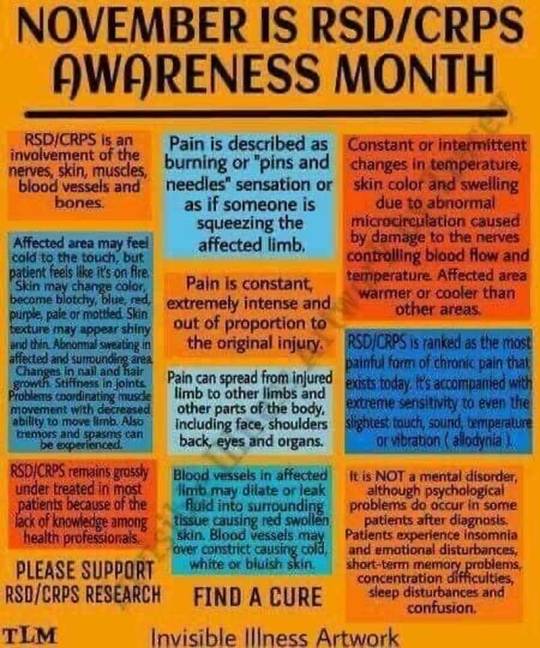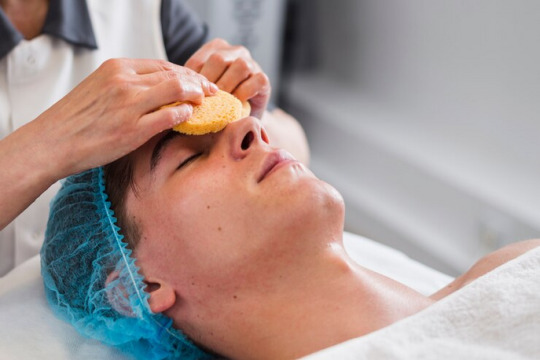#reflex sympathetic dystrophy
Text

#taylor swift#midnights#anti hero#Dysautonomia#chronic pain#chronic illness#dysautonomia awareness month#pure autonomic failure#autonomic nervous system#ans#PAF#MSA#multiple system atrophy#POTS#pots syndrome#postural orthostatic tachycardia syndrome#complex regional pain syndrome#CRPS#RSD#reflex sympathetic dystrophy#october slide#health
393 notes
·
View notes
Text
Okay, genuine question because I've heard it in passing but havent gotten to hear a lot of experiences about it- has medical cannabis genuinely helped crps/rsd, fibro or amps pain for you, if youve tried it? How has it affected your brain fog?
#weed#crps#crps/rsd#complex regional pain syndrome#reflex sympathetic dystrophy#amplified musculoskeletal pain syndrome#amps#amps pain#chronic pain#fibromyalgia#fibro
11 notes
·
View notes
Text
About this blog
- Submission-based blog
- Please start submissions with "[AMPS/CRPS/RSD/amplified pain/etc] culture is..."
- Mod is an adult and uses they/them pronouns
- As much as I'd love to answer questions and you are free to send some, amplified pain syndromes are confusing conditions with conflicting information out about them, so I may not always be able to answer it.
- That being said, I am not a doctor. I cannot give out medical advice.
Inspired by blogs such as @chronic-illness-culture-is
More information about AMPS/CRPS under the cut
What is AMPS/CRPS?
Amplified Musculoskeletal Pain Syndrome (AMPS) and Complex Regional Pain Syndrome (CRPS) are also known as juvenile fibromyalgia, Reflex Sympathetic Dystrophy (RSD), or causalgia. They're chronic conditions that, though not always synonymous with each other, fall under the same category of amplified pain syndromes. They're also rare (with under 200,000 cases currently known) and frequently misdiagnosed and misunderstood.
AMPS and CRPS both cause extreme muskuloskeletal pain as well as a heightened sense of pain. Though its existence has been documented back to the 1850s in America, its been labeled as "hysteria" by some because of the lack of understanding, and has been labeled the "suicide disease" by nonprofit Ferocious Fighters.
Resources for AMPS/CRPS patients:
Ferocious Fighters - non-profit for patients ages 0-21. They provide resources, care packages, support groups, as well as a list of more organizations here
RSDSA - non-profit for all ages, funding research into CRPS/RSD. This website also provides tons of literature and papers you can read up on or give to your doctors as an AMPS/CRPS patient. Theres also more resources here
An overview on AMPS
#amps#amplified musculoskeletal pain syndrome#crps#crps awareness#crps/rsd#complex regional pain syndrome#pinned post#info#reflex sympathetic dystrophy#disabled#disability
9 notes
·
View notes
Note
warning ⚠️ caps
rsd is KILLING ME.
👆🏼👆🏼👆🏼👆🏼
#fuck rsd#that’s the first tag that popped up and that tells me everything i need to know 😭#it’s like that burning pain throughout your body if i remember correct?#rsd#reflex sympathetic dystrophy
8 notes
·
View notes
Text

Absolutely in love with this design. 😍
(Source: SpoonieSisterShop)
#spinal cord stimulator#spoonie#complex regional pain syndrome#reflex sympathetic dystrophy#CRPS#RSD#chronic pain#chronic pain problems#chronic illness#chronically ill#invisible illness
4 notes
·
View notes
Text
November is RSD/CRPS Awareness Month
RSD stands for Reflex Sympathetic Dystrophy which is an order term for CRPS which starts for Complex Regional Pain Syndrome. November is the awareness month for this multi-named chronic pain condition . See the images below for more information..

View On WordPress
0 notes
Text
I really wish there was a system in place for when they're naming a Medical Condition to make sure it doesn't abbreviate to some other, wildly different medical condition
because i keep seeing posts from the ADHD girlies on here talking about "RSD flaring up" and being instinctively like ooooohhhh nooo REFLEX SYMPATHETIC DYSTROPHY nooooo oh my god that sucks that's really rare wait what does that have to do with adhd
ah
rejection sensitive dysphoria
0 notes
Text










I've said it before, and I'll say it again: @taylorswift has truly changed my life.
I have multiple chronic illnesses that are painful and extremely debilitating. They include: Reflex Sympathetic Dystrophy/Complex Regional Pain Syndrome (RSD/CRPS), Postural Orthostatic Tachycardia Syndrome (POTS), and Rheumatoid Arthritis. Because of these diseases, I had to give up my dream of going to nursing school to become a nurse; I wanted to help people like they've helped me.
I have listened to Taylor's music since she first debuted in country music. Through all of the pain flare-ups over the years, the only thing that has gotten me through it (other than my parents and sister @nhett ) has been Taylor and her music. There have been so many times that I've wanted to give up, but listening to Taylor gives me a temporary release from the pain and motivates me to keep going.
Despite my disabilities, I refused to miss seeing Taylor in concert. I have been to most of her concerts in St. Louis, sometimes going in a wheelchair. POTS, in particular, makes you faint easily, and being in big crowds doesn't help. But seeing Taylor live was always something I could look forward to.
My dream is to someday be able to tell Taylor my story and thank her for giving me the strength to get through each day. I love you, Taylor! Forever and always! Thank you for all you do for your fans! 🫶
@taylornation
#TSTheErasTour#TSTheErasTourFilm#KCTSTheErasTour#KCNight2#POTS#PosturalOrthostaticTachycardiaSyndrome#ReflexSympatheticDystrophy#ComplexRegionalPainSyndrome#RSD CRPS#TaylorSwift
2 notes
·
View notes
Text
Not gonna lie. The ol' mental health has taken a little bit of a nosedive lately.
Septembers are... bad for me. Since I can't remember the exact date, the whole month acts as a bit of an anniversary to me developing an illness that has drastically altered my life. It's not necessarily life threatening or anything, but man... it sucks big time.
Basically, when I was twelve, I jumped out of a tree and hurt my right foot a little bit. I was more embarrassed than hurt and ended up just walking it off... not knowing that something had gone catastrophically wrong.
So... that small injury caused me to develop an illness (disease? disorder? condition? nobody seems to know what to refer to this fucking thing as) called CRPS (Complex Regional Pain Syndrome / Reflex Sympathetic Dystrophy).
What does that mean?
That means that my dumb brain sometimes thinks I'm on fire. Or that I've severed a finger. Or are currently being flayed alive.
In other words, my nervous system/pain receptors don't work right and I get "flares" of intense pain on a regular basis, even without injury. Explaining all my symptoms is lengthy and quite frankly, very draining as I've spent too much of my life having to educate people on my illness. Feel free to google CRPS if you're curious.
Once I was finally diagnosed with CRPS, my doctors hoped that it would go away within five years. At the time, that seemed like such an astronomically long time for little pre-teen me...
That was twenty-four years ago.
Two-thirds of my life.
Still sick.
Yeah, turns out it might be incurable.
Like, it is what it is. I'm surviving. Not necessarily thriving... but I'm still here.
It's something.
Guess I just needed to vent about it. The realization that it has been two-thirds of my life was mainly what took a toll on me this month. Plus, I've been having more flare ups than normal lately. Gonna blame that on stress and the weather.
And yeah, this is one of the main reasons my fic has been seeing slower updates the past few months. I'm used to powering through pain but the chronic exhaustion and mental fog have been kicking my ass lately.
Kind of a funny side effect of having an illness like this is that I don't really know how much things are supposed to hurt now? Like, all of my injuries are agonizingly painful... but it's now my only frame of reference and I'm used to it?
Couple years back I didn't realize I had a dislocated shoulder for two whole days until I popped that sucker back in myself while lifting it with the other arm to stretch it. Thought I just had muscle weakness from heat exhaustion. Whoops!
Also had a botched CT scan once where all the liquid got injected into the muscle in my arm and I guess it was supposed to be a bad burning sensation if that happened but like... my arm already kinda felt like that so I didn't even notice. Scared the nurses pretty good lol.
Hmm... same arm. Ol' lefty is a little unlucky.
But yeah... the struggle is real and I'm trying to not beat myself up about slow updates and taking days or weeks off from writing. The fic will get done eventually.
And like... I'm gonna be fine.
I know CRPS has a scary nickname that I will not be repeating here, but I've survived this long. So please... don't worry about THAT.
If you have like, questions or whatever, maybe direct them to my @tyanis account as I'm rarely on this one. I still may not answer much, but still.
2 notes
·
View notes
Text
Types of Therapy for RSD and Their Benefits
RSD (Reflex Sympathetic Dystrophy) is a form of Complex Regional Pain Syndrome (CRPS). This chronic condition causes a number of debilitating symptoms, including burning pain in the extremities. Some individuals develop an extreme sensitivity to touch and tissue swelling.
RSD is a chronic condition that requires proper treatment and therapy to overcome. Restoring the quality of life is possible, but it requires one or a combination of therapies to find relief. We’ll be discussing physical, psychological, occupational, pharmacological, and alternative therapy and each therapy’s benefits.
6 Types of Therapy for RSD and Their Benefits
1. Physical Therapy
Physical therapy for RSD can involve several interventions, including:
Range-of-motion exercises
Muscle strengthening
Graded motor imagery
Functional training
Often, physical therapy is used as a first-line treatment for RSD, and there is evidence that graded motor imagery can reduce pain in adults. One big advantage of physical therapy is that it gets patients moving.
2. Occupational Therapy
RSD can cause a few symptoms that make it difficult to perform routine tasks we take for granted, like bathing, getting dressed, cleaning the house, or performing office work.
Occupational therapy can help patients learn how to adapt and start performing daily, meaningful tasks again. The goal of occupational therapy is to help a patient improve their ability to participate in daily activities or any activity they want to engage in. It uses occupations, or everyday activities, to achieve this goal.
3. Psychological Therapy
Although RSD is a neurological condition, it often coincides with anxiety, depression and stress. Chronic pain can take a toll on your mental health and exacerbate symptoms. Psychological therapy has been shown to be helpful for people with RSD.
4. Pharmacological Therapy
Pharmacological therapy for RSD focuses on restoring function and assisting with rehab programs.
5. Alternative Therapy
Alternative therapy for rejection-sensitive dysphoria may provide relief using natural methods. Since these therapies use natural methods and supplements, the side effects are much lower than pharmacological options.
6. Combining Therapies
Combining multiple therapies together is the key to success with RSD. Therapy is often based on multiple pillars, including patient education, physical therapy, psychological therapy, and pain management.
The benefit of combining therapies is that you can touch on all of these pillars at once.
A multi-angle approach to therapy for RSD will help speed up progress and allow a person to maintain strength, flexibility, and circulation in the body part experiencing pain. Otherwise, a sufferer may neglect this limb, causing loss of function, flexibility, and strength. Read more at Good Health’s Blog
3 notes
·
View notes
Note
AT really be out here smoothsharking people, hell yeah. also, petition to give silver rsd? (noooo, this toooootally isnt projection, why do you ask?) -hypeman
AT is a master of manipulation (confusing someone until they agree with him)
Are we talking Rejection Sensitive Dysphoria or Reflex Sympathetic Dystrophy?
7 notes
·
View notes
Note
oh my god so glad everyone else is the same as me when they see rsd rejection sensitive dysphoria record store day reflex sympathetic dystrophy relative standard deviation like I just. I don’t read real super dark when I see it lol
RSD IS REJECTION SENSITIVE DYSPHORIA LOL THATS JUST WHAT IT STANDS FOR!!!!!!! it would be witty if awsten chose that acronym on purpose but the lyrics arent related so i dont think hes that clever anymore
8 notes
·
View notes
Text
A Colorful Concept
National Color the World Orange Day (11/7)
Colorful stories are the best way to get people to think. I hope this colorful paradoxical concept doesn’t run out of juice and you find it appealing. ;0).
PS: The national day is to grow awareness of Complex Regional Pain Syndrome AKA Reflex Sympathetic Dystrophy.

View On WordPress
#blog#color#concept#disease#health#idea#juice#mental#national#orange#paradox#RSD#story#storytelling#tangerine
2 notes
·
View notes
Text
Beyond Borders: The Global Complex Regional Pain Syndrome (CRPS) market Offers Hope for Millions
The global Complex Regional Pain Syndrome (CRPS) market. According to a recent analysis, the market is projected to be valued at approximately US$ 103.7 million in 2023. Over the projected period of 2023 to 2033, the market is expected to grow at a Compound Annual Growth Rate (CAGR) of 2.2%, reaching US$ 129.2 million by 2033.
Complex Regional Pain Syndrome (CRPS), a chronic pain condition, poses significant healthcare challenges globally, with a rising number of individuals affected by failing back syndrome, chronic pain, and CRPS. The projected growth in the CRPS market reflects the increasing prevalence of these conditions and the growing demand for effective treatment options.
Navigate Future Trends With a Sample Report:
https://www.futuremarketinsights.com/reports/sample/rep-gb-1708
Rising Demand for CRPS Treatment Solutions:
The CRPS treatment market is experiencing growth, driven by the increasing prevalence of chronic pain conditions like CRPS. This chronic condition causes severe pain in limbs or other body parts and can significantly impact a patient’s quality of life.
Understanding CRPS and its Forms:
CRPS is a complex condition with two main types:
CRPS Type I (Reflex Sympathetic Dystrophy): Develops after an injury without nerve damage.
CRPS Type II: Occurs due to specific nerve damage or trauma.
While the long-term prognosis varies, early diagnosis and treatment are crucial for managing symptoms and preventing long-term disability.
Key Takeaways:
The global complex regional pain syndrome (CRPS) market is estimated to reach US$129.2 million by 2033, reflecting a rise from US$103.7 million in 2023.
This growth is projected at a steady compound annual growth rate (CAGR) of 2.2% throughout the forecast period.
The rising prevalence of CRPS and chronic pain conditions are key drivers for market expansion
Market Competition:
Mallinckrodt Pharmaceuticals, GlaxoSmithKline plc. Mylan N.V., Teva Pharmaceutical Industries Ltd., AbbVie, ACTAVIS, Zydus Pharmaceuticals, Inc., Sandoz, and Janssen Global Services, LL. are among the leading companies operating in the market.
Recent Developments in the Complex Regional Pain Syndrome (CRPS) Market
In August 2022, GSK plc announced the New Drug Application (NDA) for momelotinib, a potential new medicine with a proposed differentiated mechanism of action. It may address the significant unmet medical needs of myelofibrosis patients with anemia, which had been accepted by the US Food and Drug Administration (FDA).
In June 2022, Mallinckrodt plc, a global biopharmaceutical company announced the resubmission of the Company’s New Drug Application (NDA) to the USA Food and Drug Administration (FDA) for the investigational agent terlipressin. It helps to treat adults with hepatorenal syndrome (HRS), an acute and life-threatening condition with no FDA-approved treatment.
Key Companies Profiled:
Mallinckrodt Pharmaceuticals
GlaxoSmithKline plc.
Mylan N.V.
Teva Pharmaceutical Industries Ltd.
AbbVie
ACTAVIS
Zydus Pharmaceuticals Inc.
Sandoz
Janssen Global Services LLC.
Medline Plus
Key Segments Profiled in the Complex Regional Pain Syndrome (CRPS) Industry Survey:
By Therapy Type:
Physical Therapy
Therapy via Drugs
Analgesics
Antidepressants
Corticosteroids
Others
Surgical Sympathectomy
Intrathecal Drug Pumps
Spinal Cord Stimulation
By Route of Administration:
Oral Therapy
Intravenous Therapy
By Distribution Channel:
Hospital Pharmacy
Drug Stores
Retail Pharmacy
E-Commerce
By Region:
North America
Latin America
Europe Complex
Asia Pacific
The Middle East and Africa
0 notes
Text
Understanding CRPS Treatment Options in Orange County
Complex Regional Pain Syndrome (CRPS), formerly known as Reflex Sympathetic Dystrophy (RSD), is a challenging and often debilitating condition characterized by severe and chronic pain. If you or someone you know is affected by CRPS in Orange County, California, it's essential to understand the available treatment options. This guide aims to explore various approaches to CRPS treatment, highlighting evidence-based therapies and strategies to manage symptoms effectively and improve quality of life.

Understanding CRPS
CRPS is a chronic pain condition that typically affects a limb following an injury or trauma, although the pain may be disproportionate to the initial injury. CRPS is believed to involve abnormal inflammatory and nervous system responses, leading to persistent pain, swelling, changes in skin color or temperature, and motor dysfunction in the affected limb. The exact cause of CRPS is not fully understood, and the condition can be challenging to diagnose and treat.
Diagnosis and Assessment
Diagnosing CRPS often involves a comprehensive evaluation by a pain specialist or neurologist. The diagnosis is based on clinical symptoms, medical history, and exclusion of other potential causes of pain. Imaging tests such as X-rays, MRI, or bone scans may be used to assess changes in bone density or soft tissue abnormalities associated with CRPS.
Treatment Options for CRPS in Orange County
CRPS treatment in Orange County focuses on managing pain, restoring function, and improving quality of life. Treatment plans are often multidisciplinary and may include the following approaches:
1. Medication Management
Medications are commonly used to manage CRPS symptoms and provide pain relief. These may include:
Nonsteroidal anti-inflammatory drugs (NSAIDs) to reduce inflammation and pain.
Antidepressants (such as tricyclic antidepressants or serotonin-norepinephrine reuptake inhibitors) to modulate pain signals and improve mood.
Anticonvulsants (such as gabapentin or pregabalin) to alleviate neuropathic pain.
Opioid medications for severe, uncontrolled pain, used cautiously and under close supervision due to the risk of dependence and side effects.
2. Physical Therapy
Physical therapy is a cornerstone of CRPS treatment aimed at improving mobility, strength, and function in the affected limb. Physical therapists in Orange County develop individualized exercise programs focusing on gentle movements, stretching, and desensitization techniques. The goal is to gradually increase tolerance to touch and movement while reducing pain-related disability.
3. Sympathetic Nerve Blocks
Sympathetic nerve blocks involve injecting an anesthetic agent around the sympathetic nerves to block abnormal pain signals associated with CRPS. These nerve blocks can provide temporary pain relief and help identify whether sympathetic nervous system dysfunction contributes to the pain.
4. Spinal Cord Stimulation (SCS)
Spinal cord stimulation is a minimally invasive procedure that involves implanting a small device near the spine to deliver electrical impulses to nerves, disrupting pain signals. SCS can be effective for individuals with severe, refractory CRPS who have not responded to other treatments.
5. Psychological Counseling and Support
CRPS can have profound psychological effects due to chronic pain and functional limitations. Psychologists or counselors in Orange County provide cognitive-behavioral therapy (CBT), relaxation techniques, and coping strategies to help individuals manage stress, anxiety, and depression associated with CRPS.
6. Complementary and Alternative Therapies
Complementary therapies such as acupuncture, biofeedback, and mindfulness-based techniques may be incorporated into CRPS treatment plans in Orange County to enhance pain management and overall well-being.
Conclusion
Living with CRPS can be challenging, but with comprehensive treatment and support, individuals can experience improvements in pain and function. If you or someone you know is affected by CRPS in Orange County, it's important to seek care from experienced pain specialists and multidisciplinary teams who can develop personalized treatment plans tailored to specific needs and goals.
By combining medication management, physical therapy, interventional procedures, psychological counseling, and complementary therapies, individuals with CRPS can optimize their treatment outcomes and regain control over their lives. Don't hesitate to reach out to healthcare providers and pain centers in Orange County to explore available treatment options and start the journey toward better pain management and improved quality of life.
0 notes
Text
Dear spine,
We have less than 16 hours. Please calm the fuck down. It's been 7 days. We can do this.
Sincerely,
I don't like any of this either.
#spinal cord stimulator#complex regional pain syndrome#crps#crps/rsd#reflex sympathetic dystrophy#chronic pain#spoonie
3 notes
·
View notes